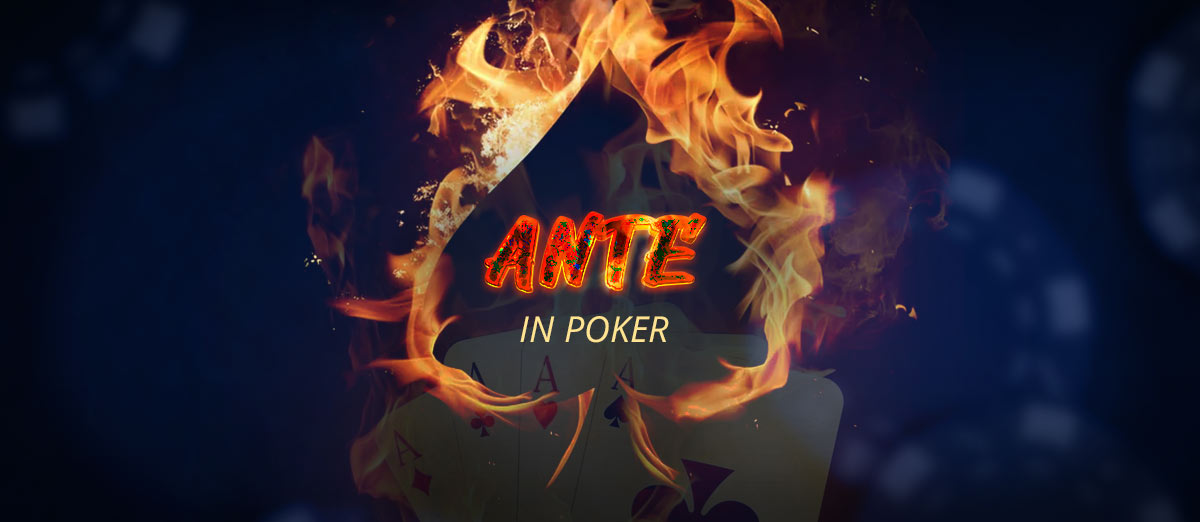The Ante Effect – Adjust Your Poker Strategy Effectively

Ante is a forced bet used in poker tournaments in addition to the blinds to build up the pot. Although live poker tournaments have recently evolved toward just one player paying the ante for everyone, every player at the table usually has to pay it.
In most cases, the ante bet will amount to about 10% of the big blind, adding approximately another big blind into the pot at a full ring table.
This actually has a massive effect, and you should change your poker strategy quite a bit in these situations.
I will take you through why it is important to switch your game up when an ante is in play and how exactly you should do that from various positions at the table.
Why Should You Change Strategy When Ante Is in Play
The answer to this question is quite simple. Every pot is bigger when antes are in play, giving players at the table an incentive to be more aggressive with their chips. By raising first in, you will have a chance to win the pot that is now significantly larger than it would be without antes.
For example, let's assume we are playing the 500/1,000 level in a poker tournament, and there is a 100 chip ante in play. At a nine-handed table, the addition of this ante will make the pot 2,400 in total (SB 500 + BB 1,000 + Antes 900) instead of the 1,500 it would be without the antes.
It simply makes stealing the dead money more valuable.
You would be making an immediate profit if we could steal the blinds around 50% of the time.
Of course, this does not take into account the pots you will win after the flop, and that's exactly what gives us that extra reason to raise it up as often as possible.
Stealing the blinds is an important concept even without the antes, but when antes are introduced in the game, it makes sense to step up your aggression by quite a bit.
Now that you know why you should be playing more hands when antes are in play, let's talk about how to do that from early, middle, and late positions.
Early Position Play with Antes
Early positions in tournament poker don't give much room for maneuvering, and you should mostly be playing quite tight from them.
You should only open about 8% to 10% hands from early positions when no antes are in play.
This range includes pocket pairs from 55 and up, suited aces from A9s and up, AQ, AK, and suited Broadway hands.
That is an exceptionally tight range to play, as we are folding hands like 98s, T9s, or 33, simply because there are too many players to act behind us.
Once the antes kick in, this range should be expanded, and you should be trying to steal the dead money in the pot more aggressively.
Natural additions to your range would be hands with blockers such as suited aces, AT, T9s – K9s, KQ, KJ, and even a few suited connectors.
Unlike our original early position raising range, this range constitutes about 20% of all hands in poker and is quite an aggressive way to play from early positions in a nine-handed game.
Middle Position Play with Antes
The default middle position range should still not include the lowest of the pocket pairs like 22 and 33, and hands like KJ and AT should still be folded.
However, that is only true if there are no antes in play. When antes do kick in, you want to expand your opening range to close to 30% of all hands.
You can do this by adding hands like A9, JT, QT, and 54s to the range you are opening from an early position.
We can also add some pretty funky hands in there, such as K6s, Q7s, and 96s, that players normally don't open from middle positions by default if you are playing against weak competition.
Late Position Play with Antes
Our tournament strategy is to generally open quite aggressively in late positions and try to win as many pots as we can on the cutoff and button.
Whether the antes are in play or not, you will want to open at least 25% of all hands on the cutoff and about 32% of all hands on the button.
However, once the antes kick in, you need to loosen up even further, especially on the button.
In fact, if the players in the blinds are passive and tight enough, you may even want to open 80% or more of all hands.
Regardless of who is in the blinds, you should open all suited hands that have any playability and hands like T9 and 98 from the cutoff and even more from the button.
Just how far you expand your range on the button really depend on the two players in the blinds and your experience with them.
When you are dealing with players who will not 3-bet you much and will be happy to give up their blinds with most hands, you should be looking to open extremely wide.
Remember that even when they defend the blinds, you will still have a great chance to win the pot on the flop by c-betting and taking it down without having to make a hand.
Looking at the Player in the Big Blind
Traditionally, most tournament players will not look to step out of line and defend in positions other than the big blind unless they have a hand that warrants it.
However, since raises in tournaments are typically quite small, the player in the big blind will always be getting a great price to defend, especially when there are antes in play.
For that reason, your main concern when thinking how wide to open should be the player in the big blind.
When an inexperienced or timid player is in the big blind, you should be looking to expand your range by an additional 5% in most cases.
Don't worry too much about the small blinds and other positions when making this decision. You are expanding your range specifically for the situations when other players fold, and it gets to the big blind.
The Impact of Big Blind/Button Ante
Live poker tournaments have adopted the big blind or button ante concept in recent years, and it is worth discussing how to adjust your strategy in such games.
The truth is that a big blind or button ante is the same as a regular ante, as it adds the same amount of chips to the pot.
For that reason, your ranges should be exactly the same as they would be in a game with regular antes, with a few exceptions.
The one major time you should possibly go for a shove wider than you do when antes are not in play is when you are sitting in the UTG position and will have to pay the big blind and the big blind ante the very next hand.
In this situation, you may want to try and steal the blinds a bit wider if you are sitting on a short stack. Shoving your ten bb now might give you a better chance of surviving the blinds if you get dealt trash hands.
This way, you will end up having more fold equity later when you are in late positions and could very well change the way your tournament goes as a whole.
It is a small but important adjustment that you need to consider when you find yourself in this spot.





Review this Blog
Leave a Comment
User Comments
comments for The Ante Effect – Adjust Your Poker Strategy Effectively